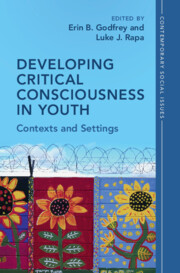Book contents
- Developing Critical Consciousness in Youth
- Contemporary Social Issues Series
- Developing Critical Consciousness in Youth
- Copyright page
- Dedication
- Contents
- Figures
- Tables
- Contributors
- Acknowledgments
- Introduction
- Part I Pedagogical, Curricular, and School-Based Contexts
- 1 Tools of Whiteness and Teaching for Critical Consciousness
- 2 Critical Consciousness Development in the Context of a School-Based Action Civics Intervention
- 3 Critical Consciousness Development in Place-Based Action Civics
- Part II Extracurricular Contexts
- Part III Societal Contexts
- Index
- References
1 - Tools of Whiteness and Teaching for Critical Consciousness
from Part I - Pedagogical, Curricular, and School-Based Contexts
Published online by Cambridge University Press: 11 May 2023
- Developing Critical Consciousness in Youth
- Contemporary Social Issues Series
- Developing Critical Consciousness in Youth
- Copyright page
- Dedication
- Contents
- Figures
- Tables
- Contributors
- Acknowledgments
- Introduction
- Part I Pedagogical, Curricular, and School-Based Contexts
- 1 Tools of Whiteness and Teaching for Critical Consciousness
- 2 Critical Consciousness Development in the Context of a School-Based Action Civics Intervention
- 3 Critical Consciousness Development in Place-Based Action Civics
- Part II Extracurricular Contexts
- Part III Societal Contexts
- Index
- References
Summary
Schools are essential sites for nurturing critical consciousness about race and racism with youth of color. Yet, limited research has taken up how critical race consciousness development can be carried out with a primarily white teaching force or about the classroom practices of white teachers who are motivated to do this work. Drawing on observational data collected over four years, this chapter describes and analyzes lessons taught by three white educators as they earnestly attempt to teach about race and racism. Ultimately, we conclude that these white teachers used meaningful, thoughtful, and rigorous curricula resources to support their students’ developing critical consciousness about race and racism, yet they encountered several pedagogical challenges that may be rooted in their socialization into whiteness. Our findings have implications for white teacher preparation and support and offer practical insights for white teachers who are actively seeking to foster critical race consciousness with their students.
Keywords
- Type
- Chapter
- Information
- Developing Critical Consciousness in YouthContexts and Settings, pp. 17 - 40Publisher: Cambridge University PressPrint publication year: 2023



